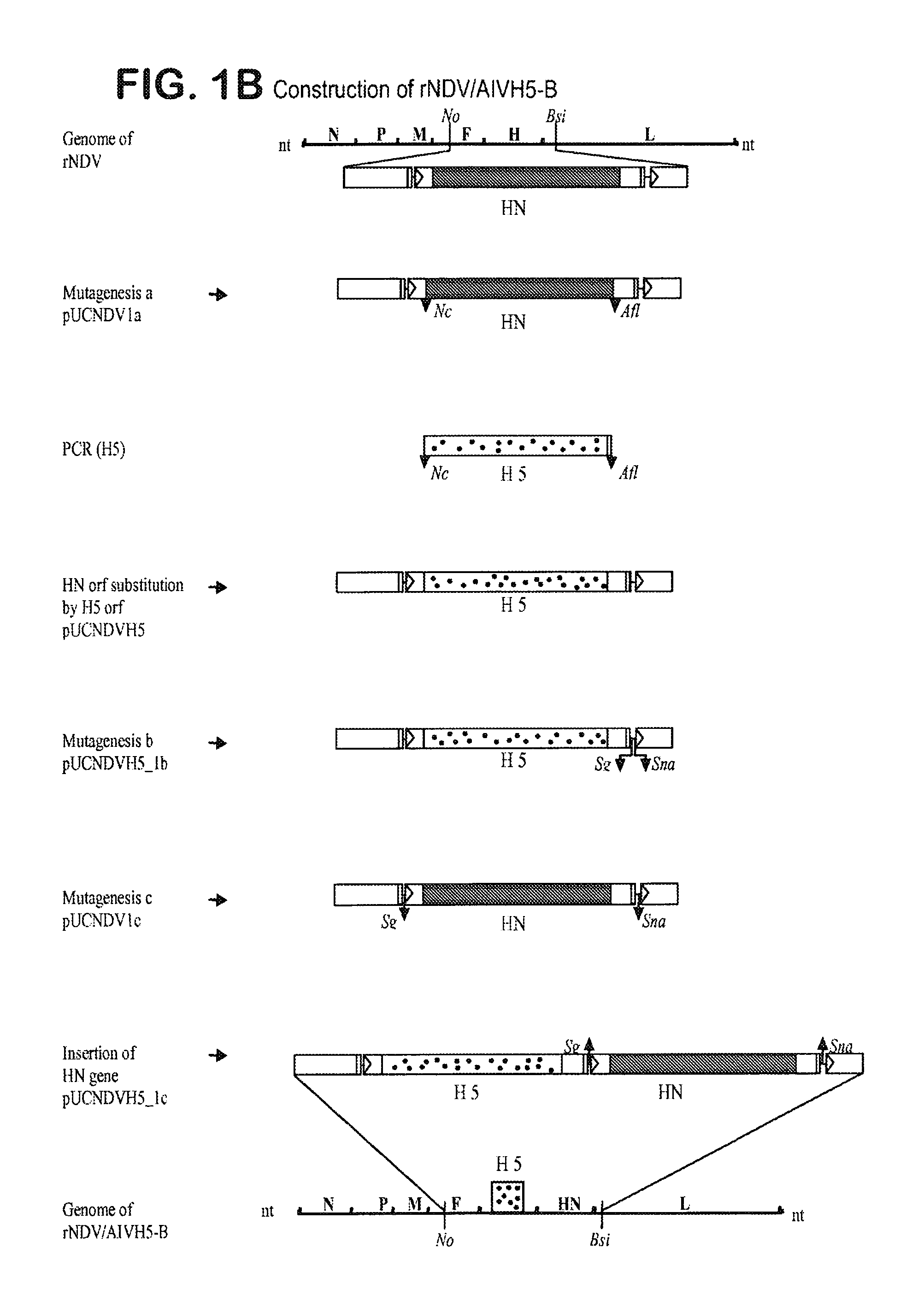Recombinant mononegaviral virus vectors
a technology of mononegaviral and virus, applied in the field of recombinant mononegaviral virus vector, can solve the problems of severe economic losses in the poultry industry worldwide, but do not disclose any advantageous effect of the so-called non-coding regions of endogenous mv genes, and achieve the effect of stronger immunogenicity and higher expression level
- Summary
- Abstract
- Description
- Claims
- Application Information
AI Technical Summary
Benefits of technology
Problems solved by technology
Method used
Image
Examples
example 1
Generation of a Recombinant MV Virus Vector Expressing an Avian Influenza Virus HA Gene (NDV / AIVH5)
Viruses and Cells
[0114]Rescued recombinant NDV and the influenza virus isolate A / chicken / Italy / 8 / 98 were propagated in specific pathogen free (SPF) 10-day-old embryonated chicken eggs. The velogenic NDV strain Herts 33156 and the NDV Clone 30 vaccine (Nobilis®) were used.
[0115]BSR-T7 / 5 cells stably expressing phage T7 RNA polymerase were used to recover infectious NDV from cDNA.
[0116]Construction of cDNA encoding NDV Antigenomic RNA Containing the AIV H5 Gene
[0117]The numbering in brackets as used herein to identify nucleotide positions on the NDV genome and amino acid residues in the NDV proteins is as described by Römer-Oberdörfer et al.(J. Gen. Virol. 80, 2987-2995, 1999, EMBL accession no. Y18898).
[0118]The plasmid pfINDV, expressing the full-length antigenomic RNA of Clone 30 (Romer-Oberdorfer et al., supra) was used to introduce the AIV H5 gene which had been amplified from plasm...
example 2
In Vitro Characterization of the NDV / AIVH5 Vector
RNA Analyses
[0123]CEF cells were infected with NDV Clone 30, rNDV / AIVH5-A, rNDV / AIVH5-B and AIV A / chicken / Italy / 8 / 98 (H5N2) at a multiplicity of infection (MOI) of 10 per cell and incubated for 8 h at 37° C. Total RNA of infected and uninfected cells was prepared, separated in denaturing agarose gels and hybridized with radiolabeled cRNA's The plasmids pCD-HA5 and pCD-NDVHN which contain the open reading frame of AIV A / chicken / Italy / 8198 (H5N2) H5 and NDV Clone 30 HN, respectively, were used for in vitro transcription of 32P-labeled cRNA (SP6 / T7 Transcription kit, Roche).
[0124]To verify transcription of the inserted AIV H5 gene in rNDV / AIVH5-A and -B Northern blot analyses were performed with total RNA of NDV / AIVH5 recombinant infected primary chicken embryo fibroblasts. RNA preparation of NDV Clone 30 and AIV A / chicken / Italy / 8 / 98 (H5N2) infected cells were used as controls. Transcription of the inserted AIV H5 gene was detected for r...
example 3
In Vivo Characterization of the NDV / AIVH5 Vector
Evaluation of Protection by Recombinant rNDV / AIVH5-A and rNDV / AIVH5-B:
[0131]One-day-old chickens were randomly assigned to two groups and vaccinated oculonasally with 106 EID50 of rNDV / AIVH5-A or with commercial NOV Clone 30 vaccine (Nobilis®, Intervet, NL) via spray. At 28 days of age a second immunization was administrated the same way. On day 12 after the second immunization blood was collected for assessing presence of NDV and AIVH5 antibodies by HI test. Two weeks after the second vaccination the immunized groups were divided and one part of each group was challenged oculonasally with 108 EID50 of the highly pathogenic AIV isolate A / chicken / Italy / 8 / 98 (H5N2). The remaining chickens were used to evaluate the protective efficacy of the vaccines against velogenic NOV. Therefore the birds and additional control animals received 105.3 EID50 of NOV strain Herts 33 / 56 intramuscularly.
[0132]After immunization and challenge infection all b...
PUM
| Property | Measurement | Unit |
|---|---|---|
| pH | aaaaa | aaaaa |
| polarity | aaaaa | aaaaa |
| width | aaaaa | aaaaa |
Abstract
Description
Claims
Application Information
 Login to View More
Login to View More - R&D
- Intellectual Property
- Life Sciences
- Materials
- Tech Scout
- Unparalleled Data Quality
- Higher Quality Content
- 60% Fewer Hallucinations
Browse by: Latest US Patents, China's latest patents, Technical Efficacy Thesaurus, Application Domain, Technology Topic, Popular Technical Reports.
© 2025 PatSnap. All rights reserved.Legal|Privacy policy|Modern Slavery Act Transparency Statement|Sitemap|About US| Contact US: help@patsnap.com



